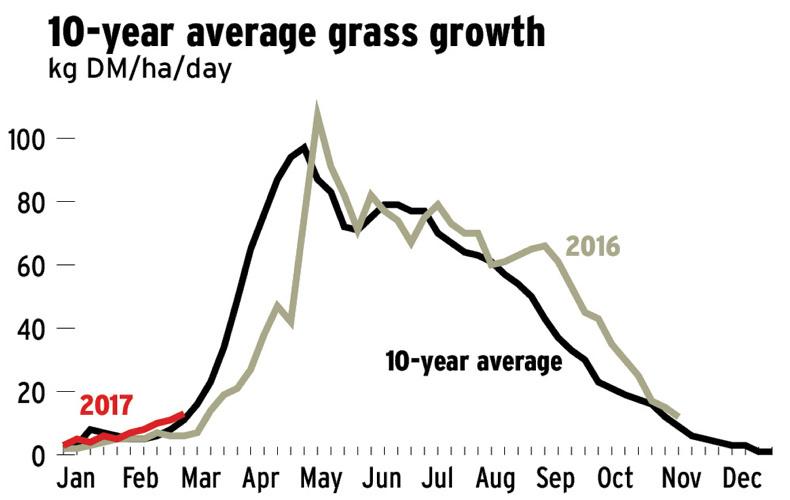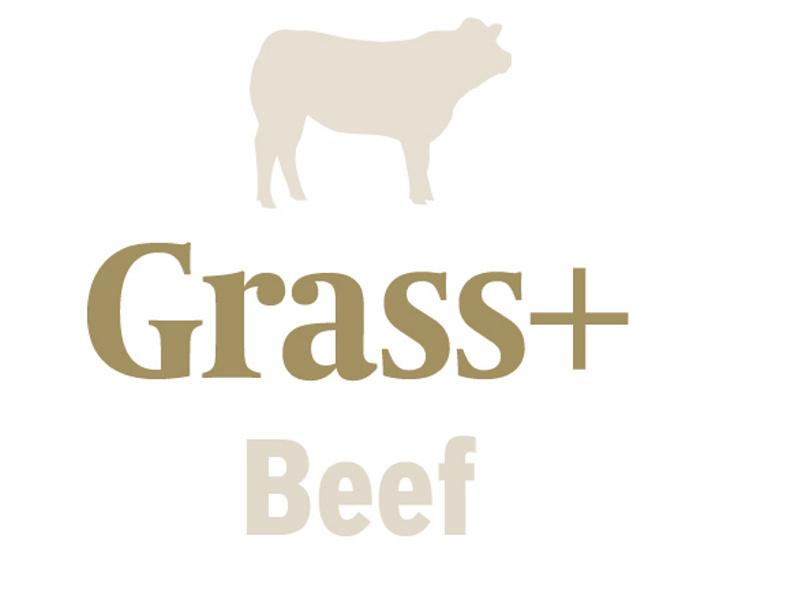A terribly wet weekend saw ground conditions decline to the extent that even those on the driest land were forced to house any stock that were out. Calmer conditions since have allowed some farmers to get light stock back to grass but numbers are small.
However, the next few days are to be relatively rain-free, and grazing should again become possible on dry farms as the ground dries.
Temperatures are also promised to lift and this should give grass growth a boost after a slower production week. Growth rates were back to 15kg DM/ha/day on our measuring farms – in line with 10-year averages and well ahead of last year.
The target of having a farm 30% grazed by the end of February was a pipe dream for many. This figure relates to dry farms, with the target for a wet farm being 30% by 10 March – equally unlikely.
The important thing now is to be in a position to get out to grass when weather and ground conditions allow. Every day counts at this point.
Don’t be in a position where you’re checking fences and fixing water troughs on the day that conditions come good for grazing – have these jobs done.
Let it be simply a matter of opening the gate when things finally improve. Walk every field on the farm in the coming days.
Get an idea of where the wet spots are and where the best grass is. Target young stock on medium covers 6cm to 8cm and cows or stores on heavier covers. Let them go to grass hungry.
Weather-wise, the coming days are ideal for fertiliser spreading, with ground obviously being the limiting factor.
Getting nitrogen out will ensure that the plant starts working for you once it’s grazed – setting up the second rotation nicely. As growth accelerates there will be a good response.
![]()
Grass growth at 15kg DM/ha/day. Grazing has ground to a halt for the most part.Potential opportunity in coming days on drier farms.Aim to get nitrogen out when conditions allow.
Hackballscross, Co Louth
Average farm cover: n/a
The ground here is very free-draining and I had my spring 2016 heifers out before the storms came last weekend. They’re back in now – there was too much damage being done.
However, last year’s autumn calves went out when the rain stopped and remain so. They weigh around 250kg, so surface damage has been minimal so far.
Going forward, I see the forecast is to improve in the coming days, so I should get my spring heifers back out. A couple of good days should dry out the ground. In terms of silage stocks, we are not near panic stations yet.
I got all of my slurry out in late January and half a bag of urea on some of the ground. I find there’s a better response to CAN than urea on this farm, for whatever reason.
Our opening farm cover was a healthy 980kg DM/ha a few weeks ago. I’ll take a measurement this week and work from there. Of my 80 spring-calvers, there are 20 left to calve. All has gone well thus far.

Sallins, Co Kildare
Average farm cover: 893kg DM/ha
I had to abandon grazing when last week’s rain came. There was a small number of yearling heifers out but all stock are now indoors. We are low-lying here and there are high water tables to contend with. I estimate that 60% of the farm is waterlogged at the moment.
That said, we were growing 18kg DM/ha daily up to last Tuesday. With the forecast good for the weekend, I hope to get stock out in the coming days. I have some covers around 10cm that I would love to be grazing.
We use straw bedding here and I was lucky in that I got a lot of our straw spread in January. I have a straw blower too, so there were no big lumps and it has broken down well. It went on my low-index (P and K) fields and these will get urea after grazing. I did spread urea on a portion of the farm three weeks ago at a rate of half a bag.
Heifers weighed 387kg and bulls 440kg last week. Both are heading back to grass when conditions allow.

Kilnamartyra, Co Cork
Average farm cover: 1,672kg DM/ha
I have loads of grass and had 35 cows and calves out before the weather turned. We got sleet and snow here – it was awful. They’re back in now. I’m weary of my silage stocks. I thought I was fine in 2012 and ran out!
That said, two or three dry days would turn things back in our favour and stock could go back out. At this stage, my bulling heifers would normally be out two or three weeks. There are savage heavy covers (>12cm) in places on the farm.
There are 40 of 55 calved and we are in a welcome lull period at present. I’ve noticed that calves are getting bigger as the season is progressing, so remaining cows are on straw and restricted silage.
Bulls are now on concentrate/straw diets to save silage and building towards ad libitum meals. They’re weighing in at 521kg and have achieved 1.25kg daily since their last weighing. I got great weight gain on them while on silage. It was 74% DMD and they were getting just 2kg of meals.

Dromard, Co Sligo
Average farm cover: 566kg DM/ha
I’m growing 9kg DM/ha daily at the moment, but ground is very soft. It rained nonstop last week and the cold conditions hit growth rates too. We’ve got no fertiliser out, but silage ground got 2,000 gallons an acre some weeks ago and is greening up nicely. This will be grazed first and closed up.
I need to try and cut as early as possible to make good silage for my autumn-calvers. We have exceeded 70% DMD in recent years, allowing us to get by with very little meal input.
At present there are six heifers outdoors and my autumn calves are creeping out of the shed. They’re doing no damage and I’m happy with their performance. Getting the young calves to go out and graze is helping with my silage stocks too. They’re getting a high proportion of their intake from grass.
While there are lots of bales in the yard, I don’t want to push it tight. I’ll wean these completely in May/June. Ideally they’ll get a decent stint at grass beforehand – I want to drive cheap calf weight gain outdoors.

Read more
Grass+ dairy: weather woes continue but forecast looking better
A terribly wet weekend saw ground conditions decline to the extent that even those on the driest land were forced to house any stock that were out. Calmer conditions since have allowed some farmers to get light stock back to grass but numbers are small.
However, the next few days are to be relatively rain-free, and grazing should again become possible on dry farms as the ground dries.
Temperatures are also promised to lift and this should give grass growth a boost after a slower production week. Growth rates were back to 15kg DM/ha/day on our measuring farms – in line with 10-year averages and well ahead of last year.
The target of having a farm 30% grazed by the end of February was a pipe dream for many. This figure relates to dry farms, with the target for a wet farm being 30% by 10 March – equally unlikely.
The important thing now is to be in a position to get out to grass when weather and ground conditions allow. Every day counts at this point.
Don’t be in a position where you’re checking fences and fixing water troughs on the day that conditions come good for grazing – have these jobs done.
Let it be simply a matter of opening the gate when things finally improve. Walk every field on the farm in the coming days.
Get an idea of where the wet spots are and where the best grass is. Target young stock on medium covers 6cm to 8cm and cows or stores on heavier covers. Let them go to grass hungry.
Weather-wise, the coming days are ideal for fertiliser spreading, with ground obviously being the limiting factor.
Getting nitrogen out will ensure that the plant starts working for you once it’s grazed – setting up the second rotation nicely. As growth accelerates there will be a good response.
![]()
Grass growth at 15kg DM/ha/day. Grazing has ground to a halt for the most part.Potential opportunity in coming days on drier farms.Aim to get nitrogen out when conditions allow.
Hackballscross, Co Louth
Average farm cover: n/a
The ground here is very free-draining and I had my spring 2016 heifers out before the storms came last weekend. They’re back in now – there was too much damage being done.
However, last year’s autumn calves went out when the rain stopped and remain so. They weigh around 250kg, so surface damage has been minimal so far.
Going forward, I see the forecast is to improve in the coming days, so I should get my spring heifers back out. A couple of good days should dry out the ground. In terms of silage stocks, we are not near panic stations yet.
I got all of my slurry out in late January and half a bag of urea on some of the ground. I find there’s a better response to CAN than urea on this farm, for whatever reason.
Our opening farm cover was a healthy 980kg DM/ha a few weeks ago. I’ll take a measurement this week and work from there. Of my 80 spring-calvers, there are 20 left to calve. All has gone well thus far.

Sallins, Co Kildare
Average farm cover: 893kg DM/ha
I had to abandon grazing when last week’s rain came. There was a small number of yearling heifers out but all stock are now indoors. We are low-lying here and there are high water tables to contend with. I estimate that 60% of the farm is waterlogged at the moment.
That said, we were growing 18kg DM/ha daily up to last Tuesday. With the forecast good for the weekend, I hope to get stock out in the coming days. I have some covers around 10cm that I would love to be grazing.
We use straw bedding here and I was lucky in that I got a lot of our straw spread in January. I have a straw blower too, so there were no big lumps and it has broken down well. It went on my low-index (P and K) fields and these will get urea after grazing. I did spread urea on a portion of the farm three weeks ago at a rate of half a bag.
Heifers weighed 387kg and bulls 440kg last week. Both are heading back to grass when conditions allow.

Kilnamartyra, Co Cork
Average farm cover: 1,672kg DM/ha
I have loads of grass and had 35 cows and calves out before the weather turned. We got sleet and snow here – it was awful. They’re back in now. I’m weary of my silage stocks. I thought I was fine in 2012 and ran out!
That said, two or three dry days would turn things back in our favour and stock could go back out. At this stage, my bulling heifers would normally be out two or three weeks. There are savage heavy covers (>12cm) in places on the farm.
There are 40 of 55 calved and we are in a welcome lull period at present. I’ve noticed that calves are getting bigger as the season is progressing, so remaining cows are on straw and restricted silage.
Bulls are now on concentrate/straw diets to save silage and building towards ad libitum meals. They’re weighing in at 521kg and have achieved 1.25kg daily since their last weighing. I got great weight gain on them while on silage. It was 74% DMD and they were getting just 2kg of meals.

Dromard, Co Sligo
Average farm cover: 566kg DM/ha
I’m growing 9kg DM/ha daily at the moment, but ground is very soft. It rained nonstop last week and the cold conditions hit growth rates too. We’ve got no fertiliser out, but silage ground got 2,000 gallons an acre some weeks ago and is greening up nicely. This will be grazed first and closed up.
I need to try and cut as early as possible to make good silage for my autumn-calvers. We have exceeded 70% DMD in recent years, allowing us to get by with very little meal input.
At present there are six heifers outdoors and my autumn calves are creeping out of the shed. They’re doing no damage and I’m happy with their performance. Getting the young calves to go out and graze is helping with my silage stocks too. They’re getting a high proportion of their intake from grass.
While there are lots of bales in the yard, I don’t want to push it tight. I’ll wean these completely in May/June. Ideally they’ll get a decent stint at grass beforehand – I want to drive cheap calf weight gain outdoors.

Read more
Grass+ dairy: weather woes continue but forecast looking better











 This is a subscriber-only article
This is a subscriber-only article

















SHARING OPTIONS: